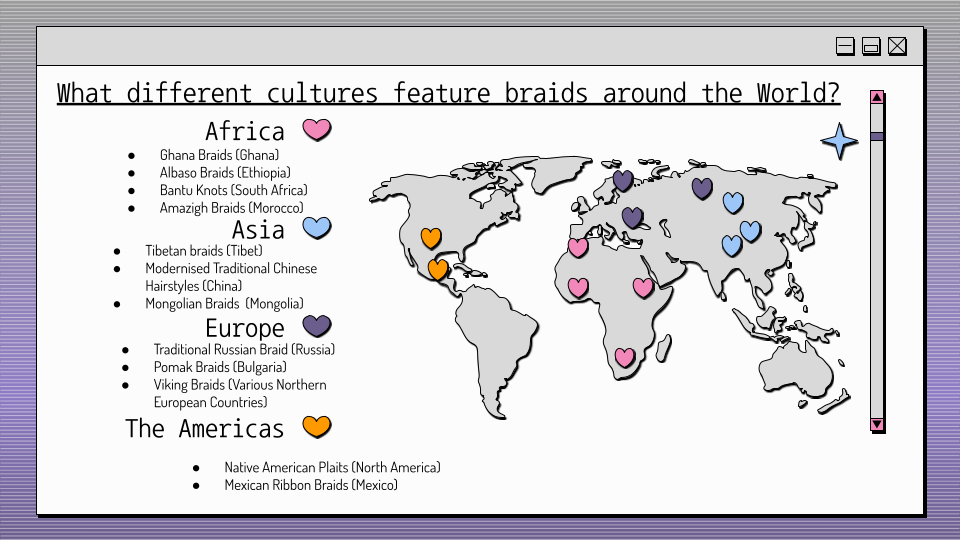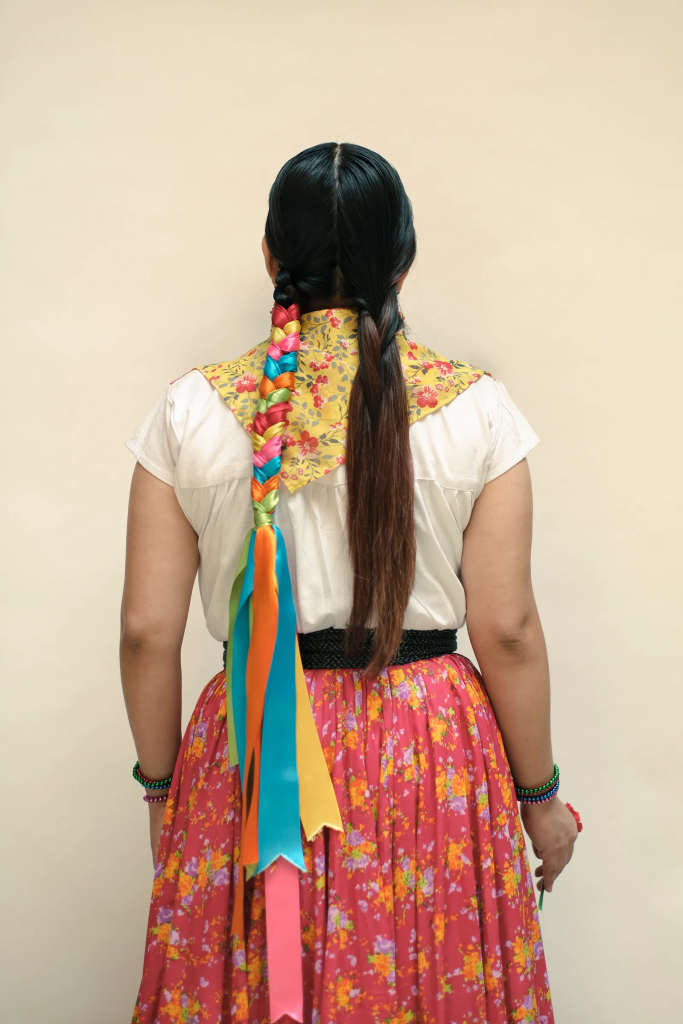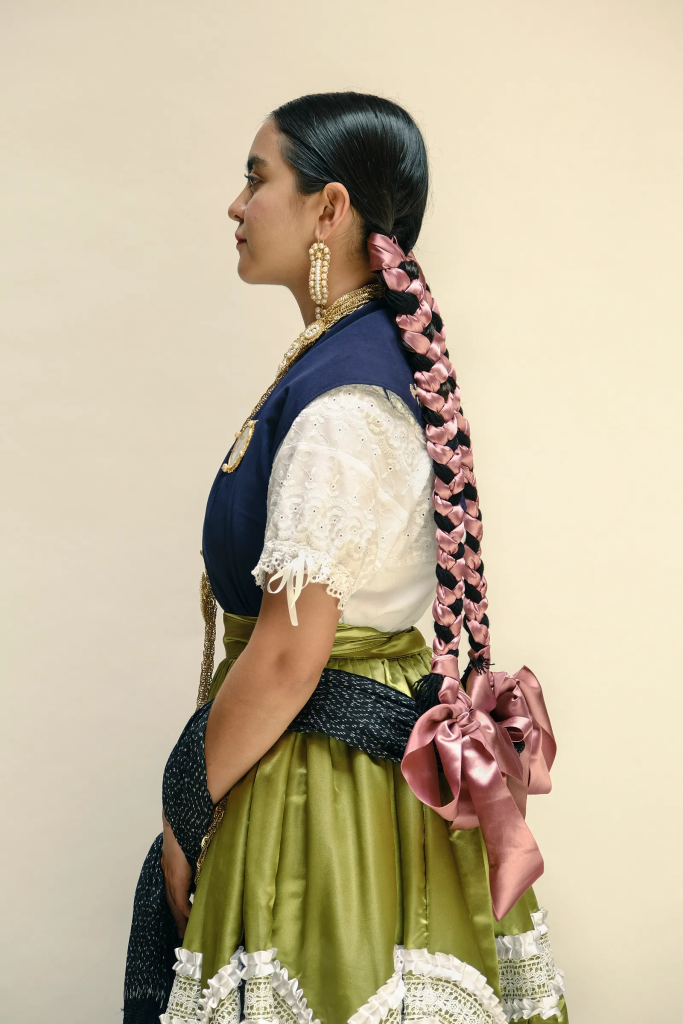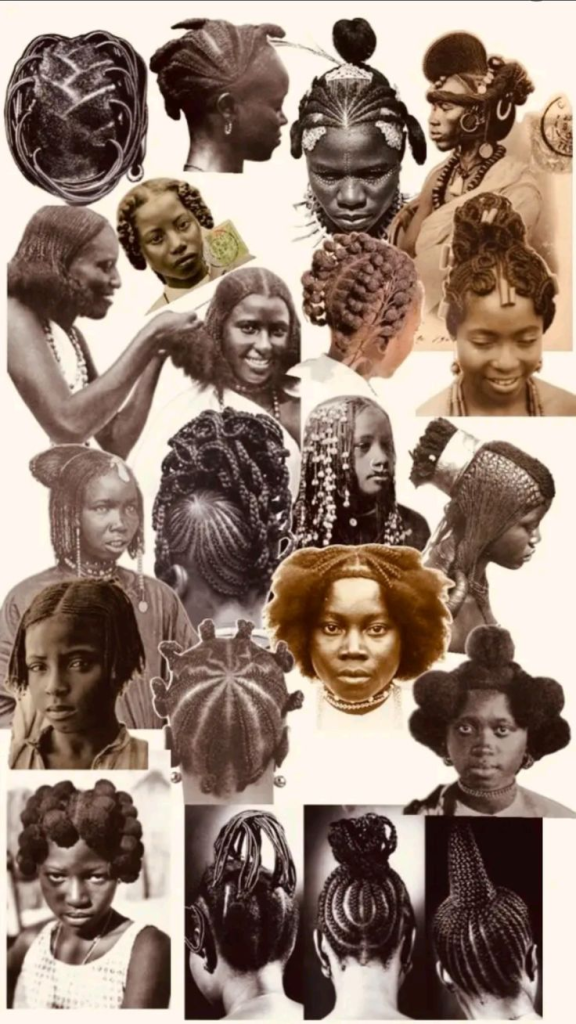
Hair Braiding exists in many different cultures around the world, from Ghana Braids in Ghana to the Pomak Braids in Bulgaria. Braids are a culturally African export that has travelled around the world, starting with the Himba People of Namibia 5000 years ago. Braiding is something of a “social art” (Sims, 2025). It elicits bonding and trust because of how long styles can take to do. People would take their time to catch up and socialise with one another – elders talking with younger people, and younger people “practising with each other” and eventually “[learning] the traditional styles” (Sims, 2025). In the 1900s, braids became extremely popular around the world — every Man, Woman or Child had their hair braided in some way.
I wanted to highlight four types of Braids unique to four different continents and peoples before I delve into my main focus on West Africa.
Albaso Braids (Ethiopia)
Albaso Braids, also known as Shuruba, are traditional braids, originating from the Habesha tribe, which is found in Ethiopia and Eritrea.
According to the afrobeatnights Instagram page, the distinguishing features of this braid are “[f]ive to seven thick cornrows, alternate thin cornrows, and voluminous, in the front hair region, leaving the curly or kinky hair behind”. This hairstyle can be worn for weddings, parties or general events/everyday life.


Mongolian Braids (Mongolia)
As stated in the name, Mongolian braids are from Mongolia. In traditional Confucianist and Daoist beliefs, it was of “utmost importance” (Asian Entertainment and Culture, 2022) to retain every part of the body, including the hair. The body was a gift from parents, so cutting or changing it in any way was an act of disrespect. Hair was a serious matter in traditional Mongolia; when reaching adult age, hair was not cut. From the “lowliest members” to the “emperor himself, men would wear their hair in braids or top knots. In the Liao dynasty, members of certain tribes/groups would shave or plait their hair in certain ways, similar to a medieval dress. Doing your hair like a Khitan (An ethnic group in modern Mongolia) would symbolise that you are one, or have allegiance to them. (Asian Entertainment and Culture, 2022)
For Married women – Hair into 2 single braids, with a hair dressing (covering), as Mongolians see hair as the extension of the body.
For Unmarried women, hair is braided into lots of tiny braids; this way, people can tell if the woman is married or not. (mongoliannomadfamily, 2024)


Pomak Braids (Bulgaria)
Pomak braids originate from the Pomak, a group of indigenous slavs who converted to Islam during the Ottoman rule. They live in Bulgaria or Northwestern Turkey, but this style is specifically from the Pomak village of Startsevo, Bulgaria. The traditional braiding technique of the Pomaks is called косичник, or kosichnik, incorporating “beads, coins and a variety of other beautiful decoration” (balkanism__, 2022). Specific types of accessories vary with each type of village. Unlike the other braids I’ve shown before, these braids start 1/8th down the length of the hair, and not immediately on top of it.
For the women and girls who wear these braids, there is a significant meaning symbolised by wearing them. As presented in these images, the braids that incorporate coins in their braids, known as “naplitane s rupove”, were traditionally worn by brides (balkanism__, 2022). “Naplitane s kalyeme”, which is braids without coins, are usually worn by unmarried women.

Oaxaca Ribbon Plaits (Mexico)
Ribbon braids are a traditional braid style hailing from the women of Oaxaca, who are preparing for the annual July festival, Guelaguetza. Each women styles her hair into “two three-strand braids and adds tlacoyales (hair adornments worn in my mesoamerican cultures), hair ties with ribbons and other adornments. (Nast, C., 2024)
According to tradition, the left side means “that the wearer is a maiden or a single woman” while the right side means that “she is already a married lady” (Nast, C., 2024). The ribbon colours don’t matter in a modern context, only made to accentuate the clothing colours. In this culture, braids often express personal status.


(West) Africa and the significance of braids
West Africa, like the other parts of Africa, has a rich history of braiding. Braids usually signified social status, marital status, tribe, religion, power or divinity. For example, the Koroba braids from the Yoruba tribe in Nigeria mean “basket”, and it looks similar to a Calabash bowl upside down. It is often embellished with charms, which adds to its look.
One of the most popular styles of braids, Cornrows, has been a part of African life and culture for centuries. A Cornrow is a type of “braid” or “plait”, where the hair is “braided firmly on the surface of the scalp”. Afro or Black Hair is unique to the human species, and so cornrows may have developed as a response to the hair texture and heat.
During the Atlantic Slave Trade, the enslaved used cornrows to hide food in their hair as well as to map out escape routes. This highlights Afro hair as a tool of resistance and its political implications with each style.
In fewer words, braids represent community and cultural connection; hair salon culture also further proves that.

Modern African Braiding
According to Beds SU for UK Black History Month 2022:
“To this day, cornrows have remained popular hairstyle many black people chose to wear. Cornrows have come to symbolise so much more than just aesthetics, the hairstyle has come to symbolise heritage, community, and strength.
Celebrities such as Alicia Keys, Laverne Cox, Beyoncé, and more, publicly display cornrows on and off the red carpet. Showcasing versatility and showing appreciation to cornrows.
Black stylists and influencers continue to innovate and share their work with the world, through social media. Inspiring millions on social media sites such as Instagram, Pinterest, and YouTube.”
Braiding nowadays has a whole bunch of different styles, my favourites being French Curls, Layered and Boho Braids. A lot of people experiment with curling, layering and “mix and matching” various braid styles/lengths to create a cool look. The possibilities are endless!


References
Maya Allen (2017). The Fascinating History of Braids You Never Knew About. [online] Byrdie. Available at: https://www.byrdie.com/history-of-braids.
Nast, C. (2024). Telling The Story Of Oaxaca’s Indigenous Culture, One Strand At A Time. [online] British Vogue. Available at: https://www.vogue.co.uk/article/oaxaca-braids.
Instagram. (2017). Afrobeat Nights Worldwide on Instagram: ‘The Albaso braids, or Shuruba, is the traditional Ethiopian hairstyle worn by the Habesha women in Ethiopia and present-day Eritrea. Five to seven thick cornrows, alternate thin cornrows, and voluminous, in the front hair region leaving the curly or kinky hair behind, are the distinguishing features of this Ethiopian braid.‘ [online] Available at: https://www.instagram.com/reel/CzrWgwZvBhU/?hl=en [Accessed 9 Oct. 2025].
Instagram. (2017). @ooomarianne on Instagram: ‘The Albaso braids is the traditional hairstyle of the habesha (from Ethiopia and Eritrea).’ [online] Available at: https://www.instagram.com/p/Cpf03looE69/?hl=en&img_index=1 [Accessed 9 Oct. 2025].
Asian Entertainment and Culture (2022). History And Significance of Mongolian Braids | Best Asian Braid Styles | Can Asians Wear Braids? [online] YouTube. Available at: https://www.youtube.com/watch?v=rcpVkC3z2SM [Accessed 9 Oct. 2025].
Instagram. (2017). MongolianNomadFamily on Instagram: ‘Do you know why we braid our hair into 2 braids??? 4 of 60Q. Do you have a similar tradition? . #Mongolianculture #mongoliangirl #mongolia #womantradition #hair #Mongolians #culturearoundtheworld’. [online] Available at: https://www.instagram.com/reel/C7Q3M4vuqfP/?utm_source=ig_web_button_share_sheet
[Accessed 9 Oct. 2025].
Instagram. (2017). B A L K A N I S M on Instagram [online] Available at: https://www.instagram.com/p/ChkHIpOof_j/ [Accessed 9 Oct. 2025].
Instagram. (2017). LOV3 STRUCK MAG on Instagram [online] Available at: https://www.instagram.com/p/C73BhCUNGae/?hl=en&img_index=6 [Accessed 9 Oct. 2025].
Nast, C. (2024). Telling The Story Of Oaxaca’s Indigenous Culture, One Strand At A Time. [online] British Vogue. Available at: https://www.vogue.co.uk/article/oaxaca-braids.
Ajao, T. (2022). Black History Month 2022: The History Behind Cornrows. Beds SU. [online] 7 Oct. Available at: https://bedssu.co.uk/post/7DR4D/black-history-month-2022-the-history-behind-cornrows.
1 thought on “Hair Braiding”